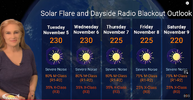The flood in Spain took an hard toll:

 www.bbc.com
www.bbc.com
Heavy hail storm in Capilla del Monte, in Córdoba Argentina:
2 dead, 515 injured, 4 missing in wake of Typhoon Kong-rey:

 focustaiwan.tw
focustaiwan.tw
On a larger scale, perturbation were detected in the Earth’s ionosphere due to a powerful explosion in the Universe:

Spain floods: Nation mourns as death toll soars past 150
At least 158 people have died in Spain's worst flooding disaster in decades as rescuers race to find victims.
Heavy hail storm in Capilla del Monte, in Córdoba Argentina:
2 dead, 515 injured, 4 missing in wake of Typhoon Kong-rey:

2 dead, 515 injured, 4 missing in wake of Typhoon Kong-rey - Focus Taiwan
As of Friday morning, strong winds and heavy rain from the storm formerly known as Typhoon Kong-rey had caused two deaths, injured 515 people and left four others unaccounted for, according to the Central Emergency Operation Center (CEOC).
On a larger scale, perturbation were detected in the Earth’s ionosphere due to a powerful explosion in the Universe:
Impact of a Supernova Explosion on the Earth’s Ionosphere according to Data of Very-Low-Frequency Sounding and Magnetometers
Abstract - Published: 18 October 2024
On October 9, 2022, orbiting X-ray and γ-ray telescopes registered the most powerful explosion ever observed in the Universe—the GRB221009A γ-ray burst at a distance of 2.4 billion light years. The response of the Earth’s ionosphere to this unique event was detected in the received signals of very-low-frequency (VLF) radio paths passing through both the daytime and nighttime ionosphere. A disturbance in the night sector was observed as a sudden decrease in amplitude up to 7 dB and a sharp jump in the signal phase up to 20°‒30°. Less pronounced amplitude jumps up to 1.5 dB were found in the daytime sector. At the time of the flare, magnetometers showed only the appearance of a weak burst of the geomagnetic field ∼0.5 nT at the time of the flare. In the daytime, an isolated geomagnetic pulse with an amplitude of up to 1 nT was observed. The appearance of a geomagnetic response to a γ-ray flare is surprising, because its radiation creates additional ionization in the stratosphere, significantly below the conducting E-layer of the ionosphere. The recorded event showed that extragalactic γ-ray bursts cause a noticeable perturbation in the Earth’s ionosphere, and the network of VLF radio paths covering the lower ionosphere can be considered as a giant γ-ray detector.

Impact of a Supernova Explosion on the Earth’s Ionosphere according to Data of Very-Low-Frequency Sounding and Magnetometers - Cosmic Research
Abstract On October 9, 2022, orbiting X-ray and γ-ray telescopes registered the most powerful explosion ever observed in the Universe—the GRB221009A γ-ray burst at a distance of 2.4 billion light years. The response of the Earth’s ionosphere to this unique event was detected in the received...link.springer.com
























